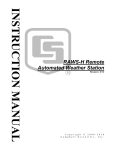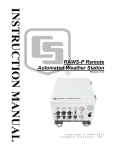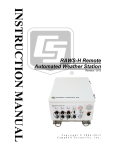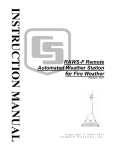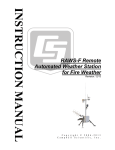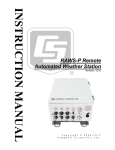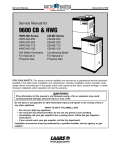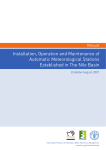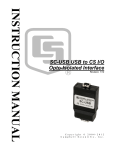Download Campbell RAWS-H Remote Product manual
Transcript
RAWS-H Remote Automated Weather Station Revision: 4/12 C o p y r i g h t © 2 0 0 6 - 2 0 1 2 C a m p b e l l S c i e n t i f i c , I n c . Warranty “PRODUCTS MANUFACTURED BY CAMPBELL SCIENTIFIC, INC. are warranted by Campbell Scientific, Inc. (“Campbell”) to be free from defects in materials and workmanship under normal use and service for twelve (12) months from date of shipment unless otherwise specified in the corresponding Campbell pricelist or product manual. Products not manufactured, but that are re-sold by Campbell, are warranted only to the limits extended by the original manufacturer. Batteries, fine-wire thermocouples, desiccant, and other consumables have no warranty. Campbell's obligation under this warranty is limited to repairing or replacing (at Campbell's option) defective products, which shall be the sole and exclusive remedy under this warranty. The customer shall assume all costs of removing, reinstalling, and shipping defective products to Campbell. Campbell will return such products by surface carrier prepaid within the continental United States of America. To all other locations, Campbell will return such products best way CIP (Port of Entry) INCOTERM® 2010, prepaid. This warranty shall not apply to any products which have been subjected to modification, misuse, neglect, improper service, accidents of nature, or shipping damage. This warranty is in lieu of all other warranties, expressed or implied. The warranty for installation services performed by Campbell such as programming to customer specifications, electrical connections to products manufactured by Campbell, and product specific training, is part of Campbell’s product warranty. CAMPBELL EXPRESSLY DISCLAIMS AND EXCLUDES ANY IMPLIED WARRANTIES OF MERCHANTABILITY OR FITNESS FOR A PARTICULAR PURPOSE. Campbell is not liable for any special, indirect, incidental, and/or consequential damages.” Assistance Products may not be returned without prior authorization. The following contact information is for US and international customers residing in countries served by Campbell Scientific, Inc. directly. Affiliate companies handle repairs for customers within their territories. Please visit www.campbellsci.com to determine which Campbell Scientific company serves your country. To obtain a Returned Materials Authorization (RMA), contact CAMPBELL SCIENTIFIC, INC., phone (435) 227-9000. After an applications engineer determines the nature of the problem, an RMA number will be issued. Please write this number clearly on the outside of the shipping container. Campbell Scientific's shipping address is: CAMPBELL SCIENTIFIC, INC. RMA#_____ 815 West 1800 North Logan, Utah 84321-1784 For all returns, the customer must fill out a "Statement of Product Cleanliness and Decontamination" form and comply with the requirements specified in it. The form is available from our web site at www.campbellsci.com/repair. A completed form must be either emailed to [email protected] or faxed to (435) 227-9106. Campbell Scientific is unable to process any returns until we receive this form. If the form is not received within three days of product receipt or is incomplete, the product will be returned to the customer at the customer's expense. Campbell Scientific reserves the right to refuse service on products that were exposed to contaminants that may cause health or safety concerns for our employees. RAWS-H Table of Contents PDF viewers: These page numbers refer to the printed version of this document. Use the PDF reader bookmarks tab for links to specific sections. 1. Introduction..................................................................1 2. Getting Started.............................................................3 3. Station Siting and Orientation ....................................3 3.1 3.2 3.3 3.4 3.5 3.6 3.7 General Description ..................................................................................3 Air Temperature and Relative Humidity ..................................................3 Precipitation..............................................................................................3 Solar Radiation .........................................................................................3 Wind Speed and Direction........................................................................4 Barometric Pressure..................................................................................4 Fuel Moisture and Fuel Temperature........................................................4 4. Sensor Wiring ..............................................................4 4.1 4.2 4.3 4.4 Air Temperature and Relative Humidity ..................................................4 Rain Gage .................................................................................................4 Solar Radiation .........................................................................................5 Wind Speed and Direction........................................................................5 4.4.1 SDI-12 Sensor.................................................................................5 4.5 Fuel Moisture and Fuel Temperature........................................................5 4.6 Barometric Pressure..................................................................................6 5. Equipment Wiring and Troubleshooting ...................6 5.1 Solar Panels ..............................................................................................6 5.1.1 General Description, Solar Panel ....................................................6 5.1.2 Wiring, Solar Panel.........................................................................6 5.1.3 Troubleshooting, Solar Panel..........................................................7 5.2 Charger/Regulator ....................................................................................7 5.2.1 General Description, 12 V Charger/Regulator (part #CH100) .......7 5.2.2 Wiring, 12 V Charger/Regulator (part #CH100) ............................7 5.2.3 Troubleshooting, 12 V Charger/Regulator (part #CH100) .............8 5.3 Battery ......................................................................................................8 5.3.1 General Description, Battery...........................................................8 5.3.2 Wiring, Battery ...............................................................................8 5.3.3 Troubleshooting, Battery ................................................................9 5.4 GOES Transmitter ....................................................................................9 5.4.1 General Description, GOES Transmitter (part #TX320) ................9 5.4.2 Wiring, GOES Transmitter (part #TX320) ...................................10 5.4.3 Troubleshooting, GOES Transmitter (part #TX320) ....................10 5.5 Voice Radio Interface .............................................................................11 5.5.1 General Description, Voice Radio Interface (part #VSP3)...........11 5.5.2 Wiring, Voice Radio Interface (part #VSP3)................................11 5.5.3 Troubleshooting, Voice Radio Interface (part #VSP3).................12 i RAWS-H Table of Contents 5.6 CR1000 Keyboard/Display .................................................................... 12 5.6.1 General Description, CR1000 Keyboard/Display (part #CR1000KD) ...................................................................................... 12 5.6.2 Wiring, CR1000 Keyboard/Display (part #CR1000KD) ............. 13 5.6.3 Troubleshooting, CR1000 Keyboard/Display (part #CR1000KD) ...................................................................................... 13 5.7 CR1000 Datalogger ............................................................................... 13 5.7.1 General Description, CR1000 Datalogger.................................... 13 5.7.2 Wiring, CR1000 Datalogger ........................................................ 14 5.7.3 Troubleshooting, CR1000 Datalogger ......................................... 14 6. Desiccant ....................................................................14 6.1 When to Replace Desiccant ................................................................... 14 6.2 Reusing Desiccant.................................................................................. 14 7. Sensor and Equipment Maintenance .......................14 7.1 Sensor and Equipment Maintenance...................................................... 14 8. References..................................................................15 8.1 RAWS Orientation................................................................................. 15 8.1.1 Determining True North and Sensor Orientation ......................... 15 8.1.2 USGS Web Calculator ................................................................. 18 Appendix A. Equipment Wiring and Connector Panel Jumper Location................................................. A-1 Figures 1-1. Color coded, keyed connector panel....................................................... 1 1-2. Inside Environmental Enclosure (optional equipment shown)............... 2 5.2-1. 12 volt charger/regulator ..................................................................... 7 5.4-1. GOES Transmitter ............................................................................. 10 5.5-1. Voice Radio Interface ........................................................................ 11 5.6-1. CR1000 Keyboard/Display................................................................ 12 5.7-1. CR1000 and printed circuit wiring panel........................................... 13 8.1-1. Magnetic declination for the contiguous United States ..................... 16 8.1-2. A declination angle East of True North (positive) is subtracted from 360 (0) degrees to find True North .................................................. 17 8.1-3. A declination angle West of True North (negative) is subtracted from 0 (360) degrees to find True North .................................................. 17 8.1-4. USGS Web Calculator....................................................................... 18 A-1. RAWS-H equipment wiring .............................................................. A-1 A-2. RAWS-H connector panel schematic 1 of 2 ...................................... A-2 A-3. RAWS-H connector panel schematic 2 of 2 ...................................... A-3 A-4. RAWS-H connector panel jumper location ....................................... A-4 ii RAWS-H Remote Automated Weather Station 1. Introduction The RAWS environmental enclosure can be used for configuring a custom Remote Automated Weather Station (RAWS) that matches the requirements of your application. The aluminum environmental enclosure houses a 12 V rechargeable battery and a CR1000 datalogger. The outside of the enclosure has color-coded, keyed connectors (Figure 1-1) for attaching the sensors. Besides the connectors, a wiring panel is included that allows the measurement of additional sensors. Communication options include satellite transmitter and voice radio interface module. Additional communication equipment (telephone, cellular phone, radio) can be added to the station. The RAWS data collection platform is ideal for configuring a custom remote automated weather station. FIGURE 1-1. Color coded, keyed connector panel NOTE Keep this manual and the CR1000KD Keyboard Display with the RAWS. Review the station siting and orientation section before field deployment. If a problem is encountered, review the troubleshooting sections in this manual and Appendix A Equipment Wiring and Connector Panel Jumper Location. 1 RAWS-H Remote Automated Weather Station CR1000KD packed in foam (may go here) (1) Connect battery Battery SC12 Cable TX320 GOES Transmitter VSP3 Vosponder (2) Turn on CH100 RF Radio CS100 Barometer CR1000 Datalogger CR1000 power in CR1000 Wiring Panel FIGURE 1-2. Inside Environmental Enclosure (optional equipment shown) NOTE 2 Customized Handar sensor programming can be developed for a nominal fee. Program development will require datalogger support software (LoggerNet or PC400) purchased from Campbell Scientific, Inc. RAWS-H Remote Automated Weather Station 2. Getting Started NOTE Set up and test your station before field deployment. NOTE Keep this manual and the CR1000KD Keyboard Display with the RAWS. Review the station siting and orientation section before field deployment. If a problem is encountered, review the equipment wiring and troubleshooting sections in this manual. NOTE After siting and leveling the RAWS station, open the enclosure and (1) connect the battery cable and (2) verify the CH100 switch is in the ‘on’ position. When this equipment is not in use (i.e., transport or storage), disconnect battery cable to the CH100. 3. Station Siting and Orientation 3.1 General Description Selecting an appropriate site for the RAWS is critical in order to obtain accurate meteorological data. In general, the site should be representative of the general area of interest and away from the influence of obstructions such as buildings and trees. WARNING If any part of the weather station comes in contact with power lines, you could be killed. Contact local utilities for the location of buried utility lines before digging or driving ground rods. 3.2 Air Temperature and Relative Humidity A temperature and relative humidity sensor should be located over an open level area at least 9 m in diameter (EPA). The surface should be covered by short grass, or where grass does not grow, the natural earth surface. The sensor must be housed inside a radiation shield and adequately ventilated. Situations to avoid include: 1) large industrial heat sources, 2) rooftops, 3) steep slopes, 4) sheltered hollow, 5) high vegetation, 6) shaded areas, 7) swamps, 8) areas where snow drifts occur, and 9) low places holding standing water after rains. 3.3 Precipitation A rain gauge should be located over an open level area covered by short grass, or where grass does not grow, the natural earth surface. Level the rain gage. 3.4 Solar Radiation A solar radiation sensor should be located to avoid shadows on the sensor at any time. Orient the solar radiation sensor where the solar radiation sensor 3 RAWS-H Remote Automated Weather Station faces south (northern hemisphere) minimizing the chance of shading from other weather station structures. Reflective surfaces and sources of artificial radiation should be avoided. Level the solar radiation sensor. 3.5 Wind Speed and Direction A wind sensor should be located over open level terrain and at a distance of at least ten times (EPA) the height of any nearby building, tree, or other obstruction. 3.6 Barometric Pressure The CS100 barometric pressure sensor can be mounted to the back plate inside the RAWS environmental enclosure. 3.7 Fuel Moisture and Fuel Temperature The fuel moisture and fuel temperature sensor should be left outside at the field site continually exposed to the same conditions as forest fuels. The fuel moisture and fuel temperature dowel rods absorb and desorb moisture from its surroundings. Install the probes horizontally on the mounting stake and face the sensors south (northern hemisphere) above a representative forest floor duff layer. Place the sensor away from foot traffic areas. 4. Sensor Wiring 4.1 Air Temperature and Relative Humidity The temp/RH sensor is connected to the RAWS connector panel “TEMP/RH” connector COLOR CODED ORANGE. This sensor is internally wired from the RAWS connector panel to the CR1000 datalogger. Connector Panel “TEMP/RH” connector COLOR CODED ORANGE Connector Pin A Temp Hi to CR1000 1L Connector Pin B Sensor excitation to CR1000 EX1 Connector Pin C Sensor signal Lo/AG to CR1000 AG Connector Pin D Power ground to CR1000 Ground Connector Pin E RH signal to CR1000 1H Connector Pin F SW_12V to CR1000 SW_12V 4.2 Rain Gage The rain gage is connected to the RAWS connector panel “PRECIP” connector COLOR CODED BLUE. This sensor is internally wired from the RAWS connector panel to the CR1000 datalogger. Connector Panel “PRECIP” connector COLOR CODED BLUE Connector Pin A Tipping Bucket to CR1000 C6 Connector Pin B 5V to CR1000 5V Connector Pin C Ground to CR1000 Ground 4 RAWS-H Remote Automated Weather Station 4.3 Solar Radiation The solar radiation sensor is connected to the RAWS connector panel “SOLAR RAD SDI-12” connector COLOR CODED GREEN. The pyranometer sensor is internally wired from the RAWS connector panel to the CR1000 datalogger. Connector Panel “SOLAR RAD SDI-12” connector COLOR CODED GREEN Connector Pin A Solar Sensor + to CR1000 3H Connector Pin B Solar Sensor to CR1000 3L/AG (3L shorted to AG) Connector Pin C Solar Sensor Gnd to CR1000 AG Connector Pin D SDI-12 Ground to CR1000 Ground* Connector Pin E SDI-12 Signal to CR1000 C5* (*Note: 2nd SDI-12 sensor) Connector Pin F SDI-12 12V to CR1000 12V* 4.4 Wind Speed and Direction The windset sensor is connected to the RAWS connector panel “WS/WD” connector COLOR CODED RED. The wind speed probe is internally wired from the RAWS connector panel to the CR1000 datalogger. Connector Panel “WS/WD” connector COLOR CODED RED Connector Pin A Sensor ground to CR1000 AG Connector Pin B Wind dir. Excitation to CR1000 Ex2 Connector Pin C Wind dir. Signal to CR1000 2H Connector Pin D Power ground to CR1000 Ground Connector Pin E +12V power to CR1000 +12V Connector Pin F Wind speed signal to CR1000 P1 4.4.1 SDI-12 Sensor An SDI-12 Sensor can be connected to the RAWS connector panel “SDI-12” connector COLOR CODED YELLOW. The wind sensor is internally wired from the RAWS connector panel to the CR1000 datalogger. Connector Panel “SDI-12” connector COLOR CODED YELLOW Connector Pin A Signal + to CR1000 C7 Connector Pin B 12V to CR1000 12V Connector Pin C Power ground to CR1000 Ground Connector Pin D Open to CR1000 4.5 Fuel Moisture and Fuel Temperature The Campbell Scientific CS506 and CS205 sensors are combined into one connector (part#CS516-LQ). This sensor is internally wired from the RAWS connector panel to the CR1000 datalogger. This sensor is connected to the RAWS connector panel “FM/FT” connector COLOR CODED BROWN. Connector Panel “FM/FT” connector COLOR CODED BROWN Connector Pin A CS205 Temp. Signal to CR1000 4L Connector Pin B Sensor Ground to CR1000 Ground Connector Pin C CS205 Temp. Excitation to CR1000 EX1 Connector Pin D CS506 FM Enable to CR1000 C8 Connector Pin E CS506 FM Signal to CR1000 4H Connector Pin F CS506 FM +12V power to CR1000 +12V 5 RAWS-H Remote Automated Weather Station 4.6 Barometric Pressure The barometric pressure sensor (part #CS100-QD) is mounted inside the RAWS environmental enclosure and the sensor wires are attached to the CR1000 printed circuit board wiring panel. CS100 Barometric Pressure Sensor wires attached to CR1000 Wiring Panel CS100 Blue wire to CR1000 wiring panel 5H CS100 Yellow wire to CR1000 wiring panel AG CS100 Red wire to CR1000 wiring panel 12V CS100 Clear wire to CR1000 wiring panel Ground CS100 Black wire to CR1000 wiring panel Ground CS100 Green wire to CR1000 wiring panel C4 CAUTION The CS100 is sensitive to static when the back plate is removed. To avoid damage, take adequate anti-static measures when handling this sensor. 5. Equipment Wiring and Troubleshooting 5.1 Solar Panels 5.1.1 General Description, Solar Panel The RAWS Solar Panel is a photovoltaic power source used for charging lead acid batteries. The SP20-Handar 20 watt solar panel is used for system configurations that have higher-than-average power requirements. It is also recommended for use at higher elevations and latitudes. The solar panel should be mounted facing south if located in the northern hemisphere, or facing north in the southern hemisphere. The SP10-Handar 10 watt solar panel is recommended for a RAWS where NO communication equipment is used. The SP20-Handar 20 watt solar panel is recommended for a RAWS where communication equipment is used (i.e., GOES, voice, cell phone, or radio). NOTE If the user supplies a solar panel for the RAWS, use an unregulated solar panel. The solar panel size depends on the station power requirements, specifically the communication equipment selected for the station. The SP10-Handar solar panel outputs 0.59 Amps, 8.9 Watts typical peak power. The SP20-Handar solar panel outputs 1.17 Amps, 18 Watts typical peak power. 5.1.2 Wiring, Solar Panel The RAWS-Solar Panel attaches to the connector panel labeled “BATT CHARGER/SOLAR PANEL”. Inside the RAWS environmental enclosure the “BATT CHARGER/SOLAR PANEL” connector pin A and pin B are wired to the CH100 charger/regulator “CHG” and “CHG” ports. Polarity does not 6 RAWS-H Remote Automated Weather Station matter; either lead can be connected to either terminal. The CH100 charger/regulator has two functions: 1) blocks any current flow from the battery to the solar panel, and 2) limits the source current to the battery. 5.1.3 Troubleshooting, Solar Panel If a problem with the solar panel is suspected, the solar panel may be checked by measuring the voltage output from the solar panel. Check the voltage with a voltmeter connected between the two leads going to the CH100 charger/regulator “CHG” “CHG” terminals located inside the environmental enclosure (15 VDC to 28 VDC). There must be solar radiation incident on the panel and there must be a load connected to the solar panel. The load can be the datalogger, other equipment, or a 75 ohm resistor capable of dissipating solar panel power between the two leads. No voltage output implies a bad solar panel, regulator, or cable. The magnitude of the voltage output depends on the incident solar radiation. Check the sensor cable. Disconnect the connector and look for damaged pins. 5.2 Charger/Regulator 5.2.1 General Description, 12 V Charger/Regulator (part #CH100) The 12 volt charger/regulator (part #CH100) is a charging regulator for 12 V rechargeable batteries. The CH100 is connected to an external charging source such as an unregulated solar panel (part # SP20-Handar or SP10-Handar) or a wall charger (part #9591-Handar). The CH100 charger/regulator has two functions: 1) blocks any current flow from the battery to the solar panel, and 2) limits the source current to the battery. FIGURE 5.2-1. 12 volt charger/regulator 5.2.2 Wiring, 12 V Charger/Regulator (part #CH100) The leads from the RAWS connector panel “BATT CHARGER/SOLAR PANEL” connector COLOR CODED PURPLE are wired to the CH100 “CHG” terminals. Polarity does not matter; either lead can be connected to either terminal. The charge indicating diode should be “ON” when voltage to the charging circuitry (CHG Terminals) is present. An internal and/or external battery can be connected to the CH100 Charger/Regulator by means of the INT (Internal) or EXT (External) 7 RAWS-H Remote Automated Weather Station connectors. The battery red lead connects to the positive battery terminal and the black lead connects to the negative terminal. Connect 12 V power to the datalogger and/or peripherals using the “+12 and Ground” terminals. The ON-OFF switch applies power to these 12 V terminals. WARNING Reversal of battery polarity will damage the CH100 or battery. CAUTION A battery must be attached for the CH100 to function correctly as a power supply. CAUTION It is possible to leave two batteries connected. The battery connections are diode isolated; however, if one of the batteries fails, it could draw all the charging current and the other battery will be discharged. 5.2.3 Troubleshooting, 12 V Charger/Regulator (part #CH100) If a problem with the charger/regulator (part #CH100) is suspected, the CH100 may be checked by measuring: 1) input voltage (CHG terminals) from the solar panel (15 VDC to 28 VDC) or input voltage from the AC adapter (part #9591Handar) about 18 VAC RMS, 2) charging output voltage (BATT INT or EXT terminal) with battery disconnected about 13.5 VDC to 14 VDC, and 3) power out (+12 terminals) about 11 VDC to 14 VDC. No voltage output implies a bad solar panel, regulator, or battery. Power out (+12 terminals) is controlled by the CH100 ON-OFF switch position. NOTE Power out (+12 terminals) is controlled by the CH100 ON-OFF switch position. 5.3 Battery 5.3.1 General Description, Battery The RAWS battery is a rechargeable 12 volt battery. The battery requires a regulated charging source provided by the RAWS Charger/Regulator (part #CH100) connected to an unregulated solar panel or a wall charger. WARNING RAWS rechargeable batteries are designed to be float charged. Permanent damage occurs and battery life is shortened if the battery is allowed to discharge below 10.5 volts. 5.3.2 Wiring, Battery The RAWS rechargeable battery should be connected to the CH100 charger/regulator INT (Internal) connector. The battery red lead connects to the positive battery terminal and the black lead connects to the negative terminal. If desired, an external battery can be connected to the CH100 charger/regulator EXT (External) connector. It is possible to leave two 8 RAWS-H Remote Automated Weather Station batteries connected. The battery connections are diode isolated; however, if one of the batteries fails, it could draw all the charging current and the other battery will be discharged. WARNING Reversal of battery polarity will damage the CH100 or battery. CAUTION It is possible to leave two batteries connected. The battery connections are diode isolated; however, if one of the batteries fails, it could draw all the charging current and the other battery will be discharged. 5.3.3 Troubleshooting, Battery Measure the +12 V and Ground terminal on the CR1000 printed circuit board wiring panel. Acceptable readings are +11 VDC to +14 VDC. Use PC200W software to collect the 1-HR data table from the CR1000 datalogger and review the historical record of battery voltage. 5.4 GOES Transmitter 5.4.1 General Description, GOES Transmitter (part #TX320) The High Data Rate GOES transmitter (part #TX320) shown in Figure 5.4-1 supports one-way communication, via satellite, from a Campbell Scientific datalogger to a ground receiving station. Satellite telemetry offers a convenient communication alternative for field stations where phone systems or RF systems are impractical or rendered unreliable after a tragedy to the local infrastructure. Data transmission rates of 100, 300, and 1200 bps are supported. Because clock accuracy is critically important for GOES satellite telemetry, the TX320 includes a robust, TCXO-based real-time clock and a GPS receiver. The TX320 transmitter has two siting requirements for proper operation. The GOES antenna must have a clear view of the spacecraft. The GOES antenna is directional and should be aimed at the spacecraft. Both elevation and azimuth are unique to the location of the planet and must be set. A poorly aimed antenna will cause a drop in signal strength or possibly prevent successful transmission. For more information on the GOES transmitter (part #TX320) and antenna siting, go to our website at www.campbellsci.com, enter the “TX320” in the “Search” box on the website mentioned above, and go the equipment manual. The GOES transmitter (part #TX320) manual is also provided on the ResourceDVD which ships with the RAWS Quick Deployment Weather Station. NOTE The spacecraft specific DCP-Setup parameters for the GOES transmitter must be entered in the CR1000 program. 9 RAWS-H Remote Automated Weather Station FIGURE 5.4-1. GOES Transmitter 5.4.2 Wiring, GOES Transmitter (part #TX320) The GOES transmitter (part #TX320) is mounted inside the RAWS environmental enclosure and the transmitter connections are described below; GOES Transmitter TX320 Connection inside the RAWS environmental enclosure GOES TX320 “CSI/O” Port --to-- CR1000 PC Board “CSI/O” Port using an *SC12 Cable GOES TX320 “GPS Port” --to-- GPS Antenna Cable GOES TX320 “RF Out” --to-- GOES Antenna Cable GOES TX320 “Power Port” --to-- Battery Cable Junction Connector *Note: The SC12 Cable ships with the RAWS Weather Station. 5.4.3 Troubleshooting, GOES Transmitter (part #TX320) If a problem with the GOES transmitter (part #TX320) is suspected, the TX320 may be checked by measuring the +12 V and Ground terminal on the CR1000 PC-board wiring panel. Acceptable readings are +11 VDC to +14 VDC. Check the SC12 cable connection between the CR1000 wiring panel and the TX320. Press the TX320 diagnostic button to query the state of the transmitter. 10 RAWS-H Remote Automated Weather Station 5.5 Voice Radio Interface 5.5.1 General Description, Voice Radio Interface (part #VSP3) The DACOM Voice Radio Interface (part #VSP3) shown in Figure 5.5-1 is mounted inside the RAWS environmental enclosure. The VSP3 converts data into voice messages that can be transmitted via UHF or VHF transceiver. The VSP3 Vosponder uses phonetic native text string to speech conversion, which provides for an unlimited vocabulary. The Vosponder communicates with a datalogger using the SDI-12 protocol. The VSP3 Vosponder can be integrated into an existing UHF/VHF radio network. A minimum of two radios with matching frequencies is required. The VSP3 ships preprogrammed with a voice image file for the fire weather market. NOTE A minimum of two radios with matching frequencies is required to transmit voice messages. To activate the voice file, hold down the radio microphone button and press 9 on the radio keypad. Radios can be purchased from Campbell Scientific. FIGURE 5.5-1. Voice Radio Interface 5.5.2 Wiring, Voice Radio Interface (part #VSP3) The Voice Radio Interface (part #VSP3) is mounted inside the RAWS environmental enclosure and the VSP3 connections are described below. Voice Radio Interface (part #VSP3) inside the RAWS environmental enclosure VSP3 “Ground” terminal contact --to-- CR1000 PC Board “G” VSP3 “+12V” terminal contact --to-- CR1000 PC Board “+12V” VSP3 “DATA” terminal contact --to-- CR1000 PC Board “C1” VSP3 “RADIO” RJ45 Connector --to-- UHF/VHF Radio* *Note: Maxon and Bendix King Radio cables are available from Campbell Scientific. 11 RAWS-H Remote Automated Weather Station 5.5.3 Troubleshooting, Voice Radio Interface (part #VSP3) If a problem with the voice radio interface (part #VSP3) is suspected, the VSP3 may be checked by measuring the +12 V and Ground terminal on the VSP3. Acceptable readings are +11 VDC to +14 VDC. Verify the sensor wires are securely fastened to the VSP3 connector and the CR1000 printed circuit board wiring panel. If problems persist, try a substitute. 5.6 CR1000 Keyboard/Display 5.6.1 General Description, CR1000 Keyboard/Display (part #CR1000KD) The CR1000 Keyboard/Display (part #CR1000KD) shown in Figure 5.6-1 is used to check datalogger status, display or plot sensor readings and stored values, and to enter numeric data or change port/flag state. The CR1000KD is powered from the CR1000 printed circuit board “CS I/O” connector via a standard 9-pin serial cable (part #10873) that ships with the RAWS station. Power Up Screen Press any key for Power up Screen Press ^ to turn on/off backlight Press <> to adjust contrast RAWS-H Setup Screen Press up/down arrow to select menu item Press Enter to see menu choices Press up/down arrow to highlight menu choice Press Enter to select menu choice Press Esc to move up a menu Press Enter to move down a menu FIGURE 5.6-1. CR1000 Keyboard/Display 12 RAWS-H Remote Automated Weather Station 5.6.2 Wiring, CR1000 Keyboard/Display (part #CR1000KD) The CR1000 Keyboard/Display (part #CR1000KD) connects to the CR1000 PC board “CSI/O” 9-Pin connector using a standard RS-232 serial cable (part #10873) that ships with the RAWS station. 5.6.3 Troubleshooting, CR1000 Keyboard/Display (part #CR1000KD) If a problem with the CR1000 Keyboard/Display is suspected, the CR1000KD may be checked by connecting the CR1000KD to the CR1000 PC board 9-Pin “CS I/O” connector using the 9-pin serial cable (part #10873). The CR1000KD display should be visible. Check the CH100 on/off switch. If the display is not visible, check the CR1000 wiring panel for 12 volt power. If the CR1000 is unresponsive to CR1000KD key strokes, then there might be a problem with the CR1000 datalogger. 5.7 CR1000 Datalogger 5.7.1 General Description, CR1000 Datalogger The CR1000 shown in Figure 5.7-1 provides sensor measurement, timekeeping, data reduction, data/program storage and control functions. The RAWS CR1000 datalogger includes 2 Mbytes of memory for data and program storage. A lithium battery backs up the RAM and real-time clock. The CR1000 also suspends execution when primary power drops below 9.6 V, reducing the possibility of inaccurate measurements. FIGURE 5.7-1. CR1000 and printed circuit wiring panel 13 RAWS-H Remote Automated Weather Station 5.7.2 Wiring, CR1000 Datalogger The CR1000 datalogger is mounted inside the RAWS environmental enclosure and fastened to the CR1000 printed circuit board wiring panel. Connect 12 V power to the CR1000 printed circuit board wiring panel green power connector. The CH100 ON-OFF switch applies power to the 12 V terminals. 5.7.3 Troubleshooting, CR1000 Datalogger If a problem with the CR1000 datalogger is suspected, the CR1000 may be checked by connecting the CR1000KD to the CR1000 printed circuit board 9Pin “CSI/O” connector using the 9-pin serial cable (part #10873). The CR1000KD display should be visible. If the display is not visible, check the CR1000 printed circuit board for 12 volt power. If the CR1000 is unresponsive to CR1000KD key strokes, then there might be a problem with the CR1000 datalogger. 6. Desiccant 6.1 When to Replace Desiccant A humidity indicator card and desiccant packs are provided with the weather station. Place the humidity indicator card and 2 ea. desiccant packs inside the enclosure. Desiccant packets inside the enclosure should be replaced with fresh packets when the upper dot on the indicator begins to turn pink. The indicator tab does not need to be replaced unless the colored circles overrun. A humidity indicator card (part #6571) and desiccant pack (part # 4905) may be ordered through Campbell Scientific. Desiccant packs inside of the datalogger do not require replacement under normal conditions. 6.2 Reusing Desiccant Customers can reactivate saturated desiccant packets. Care must be taken. If the heating process is too rapid, water vapor is released too quickly causing too much pressure to build up inside the packets so that the packets burst. Standard Oven Method: 1. Bake at an oven temperature of 125ºF for 2 hours. 2. Increase the oven temperature to 175ºF and bake for 2 hours. 3. Increase the oven temperature from 245ºF to 250ºF and bake for 12 hours. The optimum situation for reactivation is to use a recalculating oven that has a ramping temperature. The desiccant should bake for 16 hours, and the final temperature should be 245ºF to 250ºF. 7. Sensor and Equipment Maintenance 7.1 Sensor and Equipment Maintenance Proper maintenance of weather station components is essential to obtain accurate data. Equipment must be in good operating condition, which requires a program of regular inspection and maintenance. Routine and simple maintenance can be accomplished by the person in charge of the weather 14 RAWS-H Remote Automated Weather Station station. More difficult maintenance, such as sensor calibration, sensor performance testing (i.e., bearing torque), and sensor component replacement, generally requires a skilled technician, or send the instrument to Campbell Scientific. A station log should be maintained for each weather station that includes equipment model and serial numbers and maintenance that was performed. NOTE Consult the equipment manual for routine maintenance procedures. NOTE Contact Campbell Scientific, Inc., phone (435) 227-9000, for a RMA number before returning sensor or equipment for service. 8. References 8.1 RAWS Orientation 8.1.1 Determining True North and Sensor Orientation Orientation of the wind direction sensor is done after the datalogger has been programmed and the location of True North has been determined. True North is usually found by reading a magnetic compass and applying the site-specific correction for magnetic declination; where the magnetic declination is the number of degrees between True North and Magnetic North. Magnetic declination for a specific site can be obtained from a USGS map, local airport, or through the web calculator offered by the USGS (Section 8.1.2). A general map showing magnetic declination for the contiguous United States is shown in Figure 8.1-1. Declination angles are always subtracted from the compass reading to find True North. A declination angle East of True North is reported as positive a value and is subtracted from 360 (0) degrees to find True North as shown Figure 8.1-2. A declination angle West of True North is reported as a negative value and is also subtracted from 0 (360) degrees to find True North as shown in Figure 8.1-3. Note that when a negative number is subtracted from a positive number, the resulting arithmetic operation is addition. For example, the declination for Longmont, CO is 10.1°, thus True North is 360° - 10.1°, or 349.9° as read on a compass. Likewise, the declination for Mc Henry, IL is -2.6°, and True North is 0° - (-2.6°), or 2.6° as read on a compass. 15 RAWS-H Remote Automated Weather Station FIGURE 8.1-1. Magnetic declination for the contiguous United States 16 RAWS-H Remote Automated Weather Station FIGURE 8.1-2. A declination angle East of True North (positive) is subtracted from 360 (0) degrees to find True North FIGURE 8.1-3. A declination angle West of True North (negative) is subtracted from 0 (360) degrees to find True North 17 RAWS-H Remote Automated Weather Station 8.1.2 USGS Web Calculator The USGS provides an easy way of determining declination of a specific site. Since magnetic declination fluctuates with time, it should be adjusted each time the wind sensor orientation is adjusted. The calculator can be accessed at: www.ngdc.noaa.gov/geomagmodels/Declination.jsp. Figure 8.1-4 shows an example for Logan, UT. FIGURE 8.1-4. USGS Web Calculator In the example above the declination for Logan, UT is 12º 24′ or 12.4º. As shown in Figure 8.1-4, the declination for Utah is East (positive), so True North for this site is 360 – 12.4 = 347.6 degrees. The annual change is 7 minutes West per year or -7 minutes/year. 18 Appendix A. Equipment Wiring and Connector Panel Jumper Location FIGURE A-1. RAWS-H equipment wiring A-1 Appendix A. Equipment Wiring and Connector Panel Jumper Location FIGURE A-2. RAWS-H connector panel schematic 1 of 2 A-2 Appendix A. Equipment Wiring and Connector Panel Jumper Location FIGURE A-3. RAWS-H connector panel schematic 2 of 2 A-3 Appendix A. Equipment Wiring and Connector Panel Jumper Location 1 to 2 2 to 3 1 to 2 1 to 2 1 to 2 1 to 2 Page A-3 P15 Jumper Open Open Jumper Open P13 P20 1 to 2 2 to 3 1 to 2 1 to 2 2 to 3 A-4 Default Jumper Locations Page A-2 P22 Jumper Open Jumper Open Open Jumper P8 P19 P7 P6 FIGURE A-4. RAWS-H connector panel jumper location Campbell Scientific Companies Campbell Scientific, Inc. (CSI) 815 West 1800 North Logan, Utah 84321 UNITED STATES www.campbellsci.com • [email protected] Campbell Scientific Africa Pty. Ltd. (CSAf) PO Box 2450 Somerset West 7129 SOUTH AFRICA www.csafrica.co.za • [email protected] Campbell Scientific Australia Pty. Ltd. (CSA) PO Box 8108 Garbutt Post Shop QLD 4814 AUSTRALIA www.campbellsci.com.au • [email protected] Campbell Scientific do Brazil Ltda. (CSB) Rua Luisa Crapsi Orsi, 15 Butantã CEP: 005543-000 São Paulo SP BRAZIL www.campbellsci.com.br • [email protected] Campbell Scientific Canada Corp. (CSC) 11564 - 149th Street NW Edmonton, Alberta T5M 1W7 CANADA www.campbellsci.ca • [email protected] Campbell Scientific Centro Caribe S.A. (CSCC) 300 N Cementerio, Edificio Breller Santo Domingo, Heredia 40305 COSTA RICA www.campbellsci.cc • [email protected] Campbell Scientific Ltd. (CSL) Campbell Park 80 Hathern Road Shepshed, Loughborough LE12 9GX UNITED KINGDOM www.campbellsci.co.uk • [email protected] Campbell Scientific Ltd. (France) 3 Avenue de la Division Leclerc 92160 ANTONY FRANCE www.campbellsci.fr • [email protected] Campbell Scientific Spain, S. L. Avda. Pompeu Fabra 7-9, local 1 08024 Barcelona SPAIN www.campbellsci.es • [email protected] Please visit www.campbellsci.com to obtain contact information for your local US or International representative.






























